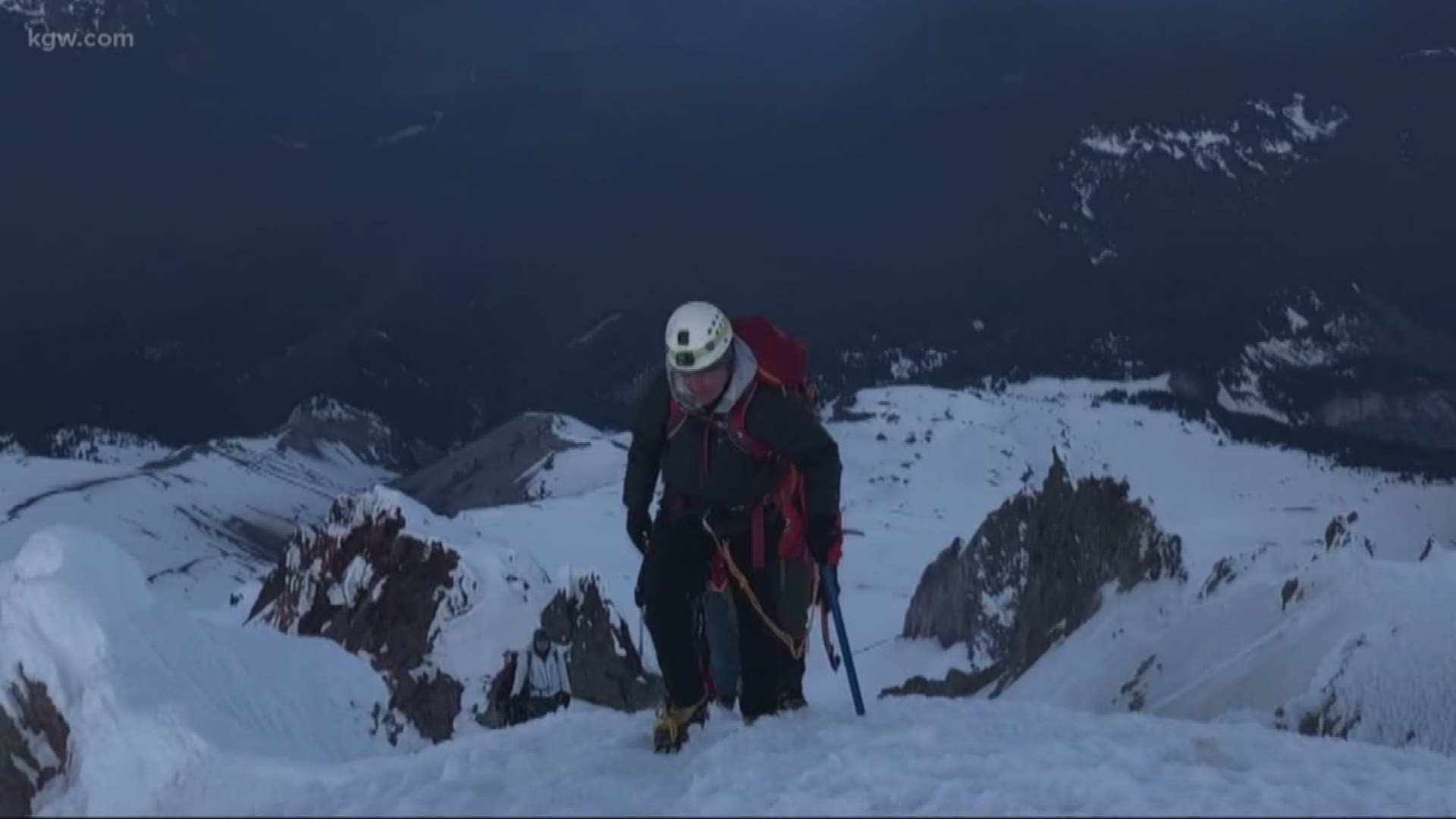MOUNT HOOD, Ore. — KGW’s Pat Dooris recently climbed to the summit of Mount Hood with the help of several members from Portland Mountain Rescue.
If you’re considering climbing Oregon’s tallest mountain someday, here are some key safety tips from Portland Mountain Rescue.
Climbing Mt. Hood requires technical climbing skills and experience
- Even on the S Side route, the upper portion of the climb is steep (45°) snow and ice, with high consequence runout. A slip is often fatal.
- In certain conditions, the climb can seem relatively simple. Previous climbers have left a boot pack so that the route is much like a stairway. Sunny skies belie the horrendous weather that can descend almost without warning.
- Crowded conditions create a false sense of security in numbers. Climbers who experience these conditions may refer to the climb as easy--just a walk up. It’s not!
- Underestimating the difficulty and danger of climbing Mt. Hood is a factor in many accidents.
Mt. Hood hosts extreme weather
- Hurricane force winds, blizzards (even in summer), freezing rain that turns climbers to ice sculptures, and dense white outs all hit Hood above tree line.
- If inclement weather is forecast in the next 24 hours, it’s better to reschedule your climb. Pinpoint forecasts that predict snow or rain at 3:00 p.m. and clear skies before are not reliable. Such a forecast simply means that the conditions on Hood are going to deteriorate rapidly sometime--anytime--that day. Don’t try to beat the weather!
- Once weather moves in, travel above tree line can be extremely difficult, if not impossible. And those conditions can last for days.
- A lenticular cloud forming at the summit is an indication that severe weather is coming. Never climb into deteriorating conditions.
Climbers should avoid congestion
- The south side routes have become very popular with climbers, hikers and skiers. On a nice Saturday or Sunday in May and June, 300 people or more may visit the crater area.
- All routes to the summit have squeeze points in the steepest terrain. These bottlenecks are too narrow for climbers to safely pass each other going up and down.
- Climbers above frequently knock ice or rocks onto climbers below.
- Climbers waiting to pass become tired, cold and irritable, which compounds risk.
- A climber who slips can take out several other climbers, especially if they are roped and not anchored.
- To avoid crowds and the attendant risk, climb on weekdays, not weekends. This is especially important if there a novices in your group.
Rock and ice fall
- The steep parts of Mt. Hood consist of loose rock glued together by ice. In the winter, the exposed ice becomes coated with a layer of rime ice several feet thick.
- When sun hits the crater walls, the melt frees a shower of ice and rock. Climbers who are still on the crater walls after the sun hits are lucky if whizzing projectiles leave only a zinging sound in their ears. Frequently, they are bruised by mid-sized chunks that strike their arms or legs. Sadly, larger chunks result in a fatality every few years.
- To minimize this risk, climbers should time their climb to avoid the crater walls after the sun hits the upper cliffs (around 8:00 or 9:00 in May and June).
If roped, set anchors
- Traveling as a roped team without setting anchors is an appropriate technique for low angle glacier travel. It is not a safe technique for the steeper terrain of upper Mt. Hood.
- Often, conditions on Mt. Hood are such that climbing without a rope belay is a reasonable choice, although correct use of an ice axe is necessary for self -belay.
- When the surface is frozen, however, ice may be too hard for effective ice axe belay, and the safety of a rope belay is necessary. In these conditions, a rope team must set anchors and attach their rope so that the anchors can stop a fall. Otherwise, if one member of the team falls, the whole rope team gets ripped off the mountain. They slide and tumble in a ball of ropes, axes and crampons, sometimes sweeping other climbing parties with them.
- Climbing roped without anchors has been a critical factor in some of the worst climbing accidents on Mt. Hood.
- Climbers often have false confidence that they can self-arrest with their axe. In firm conditions, self-arrest skills may slow your slide or help orient your body to protect vital organs, but few climbers are able to actually arrest a fall after a few feet of acceleration.
Navigation on Mt. Hood in poor visibility is not intuitive
- On a sunny day, climbers can see the ski area and Timberline Lodge and descend right to them.
- In poor visibility, no landmarks are available to aid navigation above tree line.
- The natural fall line leads climbers down from Crater Rock to the southwest into the cliffs of Mississippi Head. There they face vertical cliffs or 50 to 150 feet.

